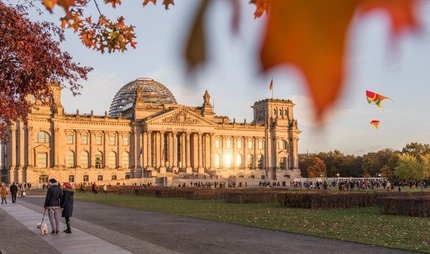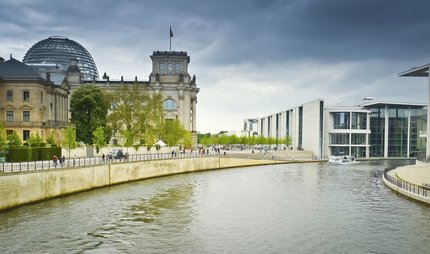
German Chancellery
Political transparency for the citizens
Berlin’s Federal Chancellery houses the offices of the German Chancellor – and is the modern counterpart to the Reichstag Parliament building.
Set close to the Reichstag Parliament building, Berlin’s modern and elegant Federal Chancellery, with its open architecture, embodies a clear message of transparency – and was designed in that spirit from the start. In contrast, only in the late 1990s did the grand neo-classical Reichstag receive its own symbol of parliamentary transparency – the famous glass dome with its stunning views out across the city and into the plenary chamber itself.
History of the Chancellery
The architectural competition for the new Chancellery was won by Berlin-based architects Axel Schultes and Charlotte Frank with a spectacular award-winning design which included the surrounding complex of buildings. The Chancellery ranks as among the most impressive structures in this new government quarter, and is the largest government headquarters in the world – eight times larger than Washington’s White House.
When Germany was divided in the post-war years, Bonn became the capital of West Germany and East Berlin the capital of East Germany. In 1991, two years after the Wall fell, the Bundestag voted for Berlin as the capital of a reunited Germany – which also entailed creating a new government district in the heart of the city. Under then Chancellor Helmut Kohl (in office 1982 – 1998), a competition was announced for the new government district along the River Spree. Work started on the Chancellery in 1997 and it was finished in 2001.
The Chancellery comprises the nine storey main building, together with the two administrative wings. This complex is integrated into a 102-metre-wide ribbon of federal buildings known as the “Band des Bundes”, which forms a clasp across the Spree, linking the east and west of the long-divided city. The Chancellery’s most striking feature is the semi-circular setting for the upper glass façade. This shape, which is 18 metres high, seems to recall a washing machine door, and has led to the building being nicknamed the “washing machine”. The new Bundestag buildings also include the Paul Löbe House and Marie Elisabeth Lüders House, located at the eastern end of the complex, to the north of the Reichstag.
Glass and light
The architecture is strongly informed by the post-modern style. The Chancellery glass façades, emblematic of the transparency of modern government, appear to be structured by columns. Yet these soft contours actually belong to twelve-metre-high stelae dividing the space and creating lines of perspective where the building’s exterior and interior merge.
© berlin-lights.com; Foto: Enrico VerwornerIlluminated ship in front of the German Chancellery
Previous Next
© berlin-lights.com; Foto: Enrico Verworner
Illuminated ship in front of the German Chancellery
Previous Next
© berlin-lights.com; Foto: Enrico Verworner
Illuminated ship in front of the German Chancellery
Previous NextThe Chancellor’s Office
The Chancellery houses the offices of the Chancellor with, for example, the cabinet room on the sixth floor. The main building also contains the offices of the Head of the Federal Chancellery, the Ministers of State and their closest staff. The other administrative offices are in the side wings. The main building also serves as an impressive backdrop for receiving state guests. The foyer has the dimensions of a cathedral while, with their transparent design and balconies, the Chancellor's reception floors offer wonderful views out across Tiergarten Park.
The first floor is home to all the former Chancellors of the Federal Republic of Germany – or rather, their official portraits! Many of Germany’s Chancellors commissioned major German artists to paint these works. For example, the portrait of Gerhard Schröder (in office 1998 to 2005) is by Jörg Immendorf, while Helmut Schmidt (in office 1974 to 1982) was immortalised by Bernhard Heisig.
The forecourt, where state guests are received, is also the site of the monumental iron sculpture Berlin by the Spanish artist Eduardo Chillida. The sculpture, which is over five metres high, embodies the idea of separation and union.
In the spirit of transparency which informs its architecture, the Chancellery also has an annual Open Day when the building can be visited by the general public.
Sights in the vicinity:
- Reichstag Parliament building
- Paul-Löbe-Haus
- Marie-Elisabeth-Lüders Haus
- Tiergarten
- Tipi am Kanzleramt
- Haus der Kulturen der Welt – arts venue and cultural centre













